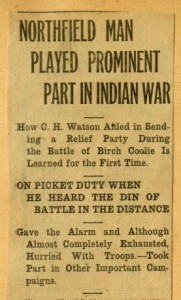 Today Minnesotans and Americans remember Dec. 26, 1862, when the largest mass hanging in our nation’s history took place at Mankato. On that day, 38 Dakota men were executed during the U.S.-Dakota War. You can read more about the war and the executions here.
Today Minnesotans and Americans remember Dec. 26, 1862, when the largest mass hanging in our nation’s history took place at Mankato. On that day, 38 Dakota men were executed during the U.S.-Dakota War. You can read more about the war and the executions here.
Mankato’s not far away, but items in the Northfield History Collaborative’s online collection can help us get an even more local look at the events — or at least what viewpoints people here were exposed to.
Included in Emily Bierman’s Minnesota History Scrapbook, compiled in the 1930s and in the care of the Northfield Public Library, is an article about the executions from the Minneapolis Sunday Journal of Feb. 11, 1900. (It continues on the two pages following.) As you read the article, you’ll notice that it does not necessarily tell the story as we hear it today. But it is still of historical value to read the materials that our ancestors did about the situation. It helps us to better understand why they held the viewpoints they did, even if we may disagree with them today.
One other item in the scrapbook is an account of the life of Northfielder Charles H. Watson. He was a member of a military company that fought in the U.S.-Dakota War, and he was present at the hangings in 1862. This Northfield Independent article notes that Watson was loathe to talk about his experiences, and here pieces them together through a conversation between Watson and fellow Northfielder G. M. Phillips.
Watson was the father of notable locals Earl, Clara and Helen Watson. He died in 1914 and is buried in Oaklawn Cemetery.
Read another account of Watson’s experiences in Old Rail Fence Corners — search here for “Mr. C. H. Watson—1855.” (The book contains accounts of Minnesota pioneers that were compiled by the Daughters of the American Revolution.)
Another venue for learning more about U.S.-Dakota relations: Watch the 2005 documentary “Dakota 38” tonight on TPT’s Minnesota Channel at 7:30.
